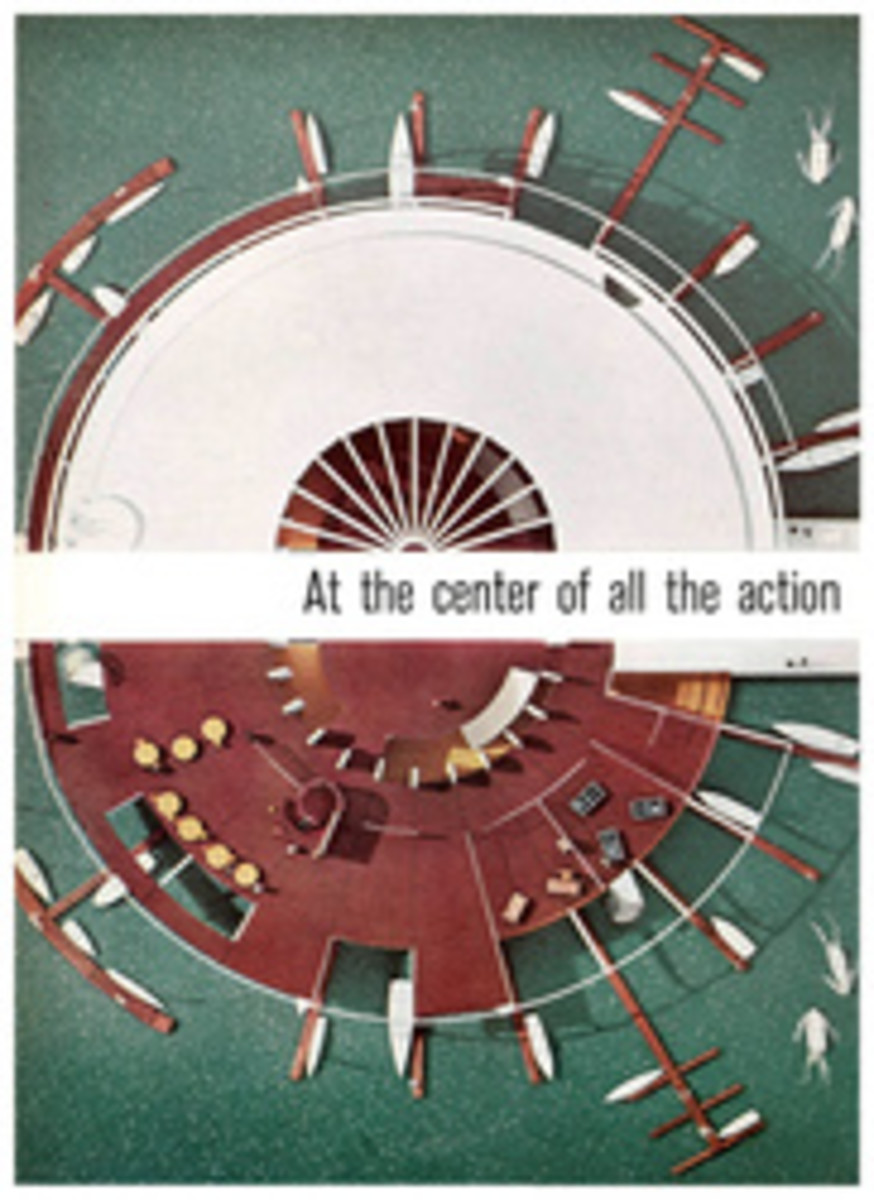
AN IDEAL YACHT CLUB
At the center of all the action stands the clubhouse
Take a yacht club—any yacht club—on an ordinary summer afternoon. Out on the floats an outboard sailor is tinkering with his engine. Near by, a racing sailboat is tied up, but its owner is 300 yards away, drying his sails on the grassplot just above the beach. On the other side of the clubhouse where the marine railway leads up to the boatyard, an amateur ship's carpenter is scraping the bottom of a hauled-out boat far from the cooling comfort of the club bar. Meanwhile, half a mile or more out on the bay, a fleet of class boats is rounding the leeward mark amid a flutter of spinnakers invisible to the members and guests gathered in the seclusion of the dining room.
"Where's Dad?" someone may ask. "I think he took the station wagon and went down to the boatyard," will come the answer. "Well, I'll see if I can find him. I'll meet you up in the bar later, and then maybe we can find a boat and get out to see the races."
"In the ideal yacht club," says Bill Ficker, a tall, bald and lanky Californian, "comments like these, indicating a wide separation of activities, would never be heard." Ficker ought to know. A prosperous architect who has designed many of the fashionable Newport Harbor homes (including Briggs Cunningham's Lido Isle estate), he has spent most of his 35 years racing sailboats, from tiny Sabots and Snowbirds on up to mighty ocean-treading greyhounds like Howard Ahmanson's Sirius II. In 1958 he raced his Star to a world championship.
"The architecture of any yacht club should be an outgrowth of all the club's functions," Ficker says. "Its activities should be integrated, as they are in many golf clubs. There the locker room, bar and dining room are all handy to the first tee and the last green. The whole club membership is projected into the game of golf, and that concept can be applied to yachting." In the half-model shown on the preceding pages and at left (with roof removed in the lower picture), Ficker shows what it takes to make a yacht club ideal.
In Ficker's dream club three basic ideas are employed to bring the disparate activities of an average yacht club together.
First, the club is projected into the water, with a ramp walkway leading out from the shore.
Second, the club is a three-level structure, with each level coordinated in the service of the club as a whole.
Third, and most visually dramatic, the club is round. "I didn't start out with a round building," Ficker explains. "I started out seeking a meaningful relationship between inside and outside activity. The people inside should feel the excitement on the water—boats docking and leaving, boats racing, flags, sails, masts, sun—and with so many things going on at once, it seemed best to allow the activity to turn on an axis. Hence the round design."
Because of its circular design, Ficker's club serves its members as a dramatic theater-in-the-round where, appropriately, yachting becomes the scenery. "Imagine a party on a balmy night," Ficker suggests. "Everyone in gowns and white dinner jackets, the walls opened to a warm breeze and, outside, completely encircling the club, a lighted backdrop of rigging and masts and yachts—a fantastic background for a formal party!"
Docks ring the club's lowest level, radiating outward like spokes from the hub of a wheel. A small railway circles the outside edge of this level, allowing easy movement of hauled-out boats and heavy gear.
In the center of the lowest level are maintenance and storage facilities—the club's boatyard—together with rest rooms, lockers, showers and a kitchen serving the dining rooms above.
Circular stairways wind around the kitchen on the boatyard deck up to the second level, where all social events take place. Here from the dining room and the bar {indicated by the yellow tables at left) members can look down on boatyard and docks through large open areas in the floor and get an unobstructed view of the bay waters beyond from the club's wide, balconylike overhanging tier. Spiral stairs (at "12 o'clock," "4 o'clock" and "8 o'clock" in the drawing above) wind upward to the club roof, the third level, which serves as an open grandstand complete with platform for the race committee ("9 o'clock"). Here spectators can watch races going on in the waters near by, or just relax in the sun and the breeze.
Just as impressive is the flexibility of Ficker's design. "This can't be a rigid, unchangeable thing," he says. "It's got to be adaptable to the area in which it is built. Take esthetics for example. In southern California, where I live, the severe, modern lines I've suggested here in the model would go quite well. On the other hand, the character of the Northwest is woody, and people that sail there might want to change the club's lines for a more traditional appearance.
"Construction materials and building costs will also vary according to location," Ficker goes on. "The design I've shown here is concrete, which I consider ideal in most instances. It weathers well, requires little maintenance, and its mass—its brute resisting force—would be an advantage in a place like Florida, where violent hurricane winds or a battering sea could be expected. Still, other materials, such as wood or steel, might be more readily available, and these certainly could be utilized with the same idea. Naturally, since I am simply envisioning an ideal, I can afford to say, 'Damn the expense.' The building as shown would come high. I would estimate the cost at around 5500,000 in warm climates, where the weather is gentle, but this cost would rise sharply in climates where insulation and central heating become a problem. The general concepts, however, could easily be trimmed and pruned to a far smaller scale and a less ambitious design."
Tradition, a vital element in any yacht club, takes on new excitement in Ficker's arrangements. Brightly lighted trophy cabinets, pictures of club commodores, of great races and famous yachts are spread throughout the second level, not confined to any one room. "The concourse around the main ballroom would be a walkway through a museum," he says. "With the readily movable panels that form the interior compartments, emphasis can be placed on any special area. For example, if a significant trophy is being raced for, it could be set apart from all the others and accented with panels around it. And since there are no corners to consider, and such vast spaces are available, there is virtually no end to the dramatic variations possible. The important thing to remember," says Sailor-Architect Ficker, "is that the principal function of a yacht club is yachting."
TWO ILLUSTRATIONS
ILLUSTRATION
ROBERT BIDWELL

